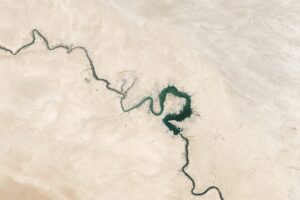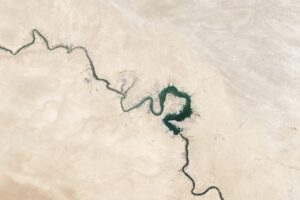We’re ignoring and devaluing the value of water
 24 Juni 2023
24 Juni 2023
Daniel Kahneman, an Israeli-American psychologist who was recognised with the Nobel Prize in Economics in 2002, gave an interview more than a decade ago in which he stated: “We associate leadership with decisiveness. That perception of leadership pushes people to make decisions fairly quickly, lest they be seen as dithering and indecisive.”
The implication is that leaders make decisions that are hasty and scarcely thought through. On many occasions, we make our decisions based on insufficient data and knowledge. Spanish writer Menchu Gutiérrez wrote in her novel Disección de una tormenta (Dissection of a Storm – 2005): “We end up drawing a map of everything we care about and do not understand, altering the true size of our ignorance in doing so.”
All decisions, therefore, are based on the intimate perceptions we have about the value of things, experiences, expectations. Whether something is chosen, minimised, or completely ignored, it is often the result of the value we place on that thing.
Something like that also happens with the value of water.
Our ignorance regarding water
Unlike common wisdom, almost everything about water is still unknown to most people:
- How a wetland can mitigate soil pollution under certain circumstances.
- What an aquifer is.
- How a seawater desalination plant can deliver potable water.
- The role of a storm tank in reducing the risk of flooding in our city.
- How diffuse pollution from nitrates contained in irrigation water discharges seriously damages the quality of groundwater.
- The state of the drinking water supply networks and sewage collection systems in our cities.
- If sediment flows at the mouth of a river are at the level they should be at.
- To what extent water scarcity is the result of a significant reduction in rainfall (drought) or a long-term characteristic of certain regions of the planet.
- Whether large investments to get more water into dams in the world will work in the context of climate change.
Urban users tend to ignore how much water we consume or the amount of the water bill.
We are equally unaware of most of the things that happen before the water reaches our tap (particularly the extraction and distribution of water in the basin).
We ignore what happens once wastewater is flushed down the toilet (and the consequences of not following the regulations on how it should be treated) and if water infrastructures are properly maintained and replaced.
Other water users (farmers, manufacturing and mining companies, hydroelectric power operators, livestock keepers, etc.) may be more aware of the real impact that water has as a critical input for their production processes, but it is very likely that, even in those cases, they ignore the consequences of their production and consumption patterns on aquatic ecosystems.
The value of water resources
There is a misconception about the value of water in general and water-related investments in particular. Every individual or collective decision we make about water is implicitly based on values, both in relation to its use (wasteful or not) and its non-use.

Water resources and the services stemming from them are critical for social and economic development – even in regions where they are a relatively abundant asset.
Water management is related to social and regional cohesion, spatial development, the geographic location of business activities, macroeconomic performance (including the productivity and competitiveness of our economies), social equity, the sustainability of development patterns, industrial symbiosis as part of circular economy, food security, the forced displacement of populations (either as migrants or refugees), power generation and other energy conversion activities (such as green hydrogen production), public health, the conservation of biodiversity and ecosystem services, and the mitigation of (and adaptation to) climate change.
In the context of less developed economies, water is also linked to greater opportunities for a meaningful life, gender equality, the reduction of absolute and relative poverty, migration between the countryside and the city, geopolitical conflicts and the chances of success of export-oriented economies.
The reality for countries and cities, from China to Colombia
The countries with the greatest availability of freshwater are not immune to critical difficulties for their water security. Brazil, with 12% of the planet’s freshwater resources (of which 70% are in the Amazon), faces a high level of structural scarcity in the northeast of the country and the three engines of its economy (the states of Rio de Janeiro, São Paulo, and Minas Gerais) suffer from increasingly frequent and intense droughts.
Russia is seeing the desert advancing in the southern Republic of Kalmykia. The 17 states of the western United States –- all subject to water stress – are experiencing the worst mega-drought of the last 1,200 years. In southwestern China, car assembly plants and electronics factories closed in the summer of 2022 due to a lack of power. The flow of the rivers was so low that ships could not carry supplies. Colombia’s energy transition is affected by droughts.
In the worst energy crisis in half a century and with a war in the heart of Europe, the main rivers in central Europe (Elbe, Rhine, Danube, etc.) have recurring navigation problems due to dwindling flow levels. As in the case of China, they have a highly disruptive impact on critical supply chains (fertilisers, semiconductors, natural gas, etc.).
Indonesia, the fourth demographic power in the world with more than 270 million inhabitants, was forced to move its capital from Jakarta to Borneo as a joint result of the rise in sea level and in land subsidence due to the overexploitation of coastal aquifers.
Peru produces 80% of its GDP and concentrates two thirds of its population on the Pacific coast, a desert with barely 2% of the country’s fresh water, generating a false sense of prosperity typical of a vigorously emerging economy – but with unequivocal liabilities in terms of sustainability.
India lives a dual reality: on the one hand, its main cities suffer from long-term water insecurity (Chennai is only the penultimate example of this) while at the same time and just like other areas in Southeast Asia (Bangladesh, Vietnam, etc.), the country is subject to floods that affect a third of its population.
As Aldous Huxley (1894-1963) pointed out in his Complete Essays (Vol. II: 1926-1929), “facts do not cease to exist because they are ignored”.
This article was written by , Director del IE Centre for Water & Climate Adaptation, IE University. It is republished from The Conversation under a Creative Commons license. Read the original article.
The post We’re ignoring and devaluing the value of water appeared first on Sustainability Times.
